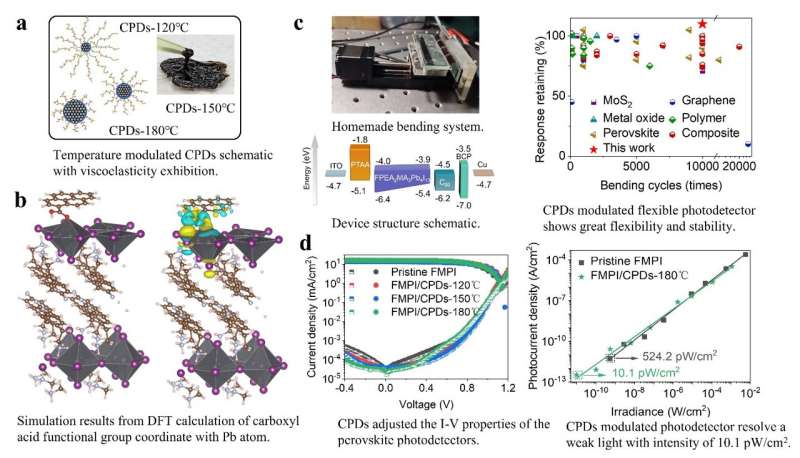a, Via controlling the carbonized temperature, the length of polymer chains can be regulated. The CPDs show strong viscoelasticity as illustrated. b, The DFT calculation results shows a coordinate effect between the carboxyl acid functional group and the unbonded Pb atom, where the electrons transfer from the Pb atom into the O atom. c, The photograph of the homemade bending system and the schematic of the fabricated photodetectors. The CPDs modulated photodetectors show great flexibility and stability, whose photo-response shows no loss after bending 10000 times. d, Through regulating various CPDs introduced with different kinds and amounts of functional groups, the photodetector devices exhibit different I-V properties, where the CPDs lower their dark current. The champion of these devices achieves a resolution of weak light with an intensity of 10.1 pw/cm², reaching an intensity of 1/50 compared to the devices without modulation. Credit: Mingrui Tan, Mingbian Li, Wanting Pan, Xiaopeng Feng, Yuhong He, Junjun Liu, Fengxia Dong, Haotong Wei, and Bai Yang
High-performance photodetectors with great detection capability have been widely deployed in our daily life, such as driverless technology, intraoperative navigated surgery, face recognition, anti-counterfeiting, and so on. However, we still face challenges as new demands are made for additional functions like excellent flexibility with no sensitivity/stability loss. Therefore, novel photosensitive materials or multi-functional composites are needed to meet the fast technology development.
In a new paper published in Light: Science & Applications, a team of scientists, led by Professor Haotong Wei from State Key Laboratory of Supramolecular Structure and Materials, College of Chemistry, Jilin University, China have developed a method to introduce carbonized polymer dots (CPDs) to promote the performance of quasi-2D perovskite based flexible photodetectors.
By controlling the morphology of the CPDs unique core/shell structure with viscoelasticity polymer chains, they greatly improved the flexible stability of perovskite photodetectors, showing no loss in photo-response after bending 10,000 times. Furthermore, the defects distributed in the grain boundary of perovskite were passivated through the coordination effect between the unbonded Pb atoms and the carbonyl groups in the CPDs' polymer chains.
The devices exhibited a lower dark current and resolve a weak light with the detectable light intensity lowing to 1/50, compared to the initial performance. The reported method provides an economical and available path to boost the photodetection performance of flexible optoelectronic devices.
The CPDs are composed of carbonized crystalline carbon as a nucleus core in the center and capped by amorphous polymer chains as shells. The size of the carbon nucleus can be easily controlled by modulating the carbonized temperature and time, and the polymer chains possess abundant functional groups, which brings tunable surface chemical properties.
Therefore, the unique core-shell structure of CPDs ensures excellent viscoelasticity and tunable optoelectronic properties of CPDs. In addition, the raw materials of CPDs are abundant in nature, and synthesis processes are also facile and low cost. Based on these considerations, these scientists proposed that perovskite/CPDs composites may exhibit excellent photodetection performance and flexibility:
"We fabricated a series of CPDs with different morphology properties. By changing the temperature, the adjusted carbonization process leads to various lengths of polymer chains on the CPDs. And as we regulated the raw materials, these CPDs would carry abundant and controllable functional groups, which meet our demands," the researchers write.
"The different lengths of the CPDs provide a convenient way to control the flexibility of the devices. The stretchable polymer chains of the CPDs would work as an anchor at the grain boundaries, making the morphology of the perovskite more stable during the deformation process. Furthermore, the abundant available raw materials of the CPDs provide us with more choices to adjust the properties of the CPDs. The various functional groups the CPDs carried in the polymer chains coordinate with the Pb atoms to passivate the defects at the grain boundaries. Via control of the functional groups, the CPDs provide a path to regulate the optoelectronic performance of the devices," they added.
"Our method contributes a new path to adjust the properties of optoelectronic materials and devices. By introducing these easy-to-prepare CPDs, we combine the properties of CPDs and perovskite materials and achieve high-performance photodetectors with great flexibility and stability. Our work would inspire and promote flexible and foldable optoelectronic devices and promote their development and advancement."
More information: Mingrui Tan et al, Carbonized polymer dots enhanced stability and flexibility of quasi-2D perovskite photodetector, Light: Science & Applications (2022). DOI: 10.1038/s41377-022-01000-6
Journal information: Light: Science & Applications
Provided by Chinese Academy of Sciences
























